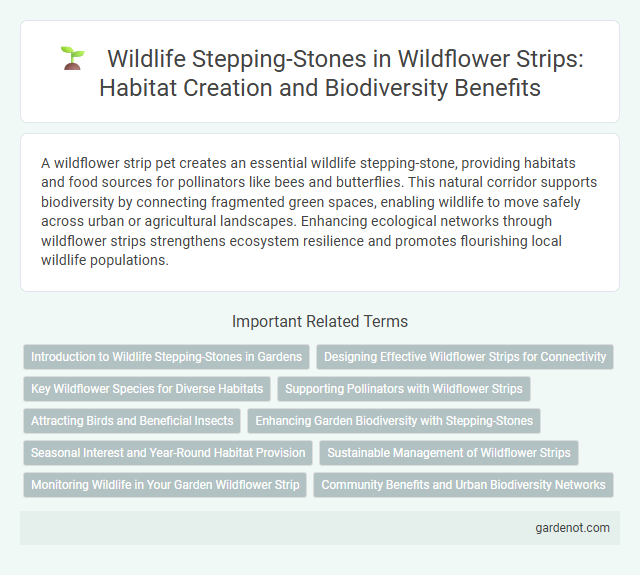A wildflower strip pet creates an essential wildlife stepping-stone, providing habitats and food sources for pollinators like bees and butterflies. This natural corridor supports biodiversity by connecting fragmented green spaces, enabling wildlife to move safely across urban or agricultural landscapes. Enhancing ecological networks through wildflower strips strengthens ecosystem resilience and promotes flourishing local wildlife populations.
Introduction to Wildlife Stepping-Stones in Gardens
Wildlife stepping-stones in gardens are small, strategically planted areas designed to connect larger habitats, enabling the safe movement of pollinators, birds, and insects. These strips of native wildflowers provide critical resources such as nectar, shelter, and breeding sites, promoting biodiversity in fragmented urban and suburban landscapes. Incorporating wildflower strips enhances ecological networks by supporting species migration and increasing genetic diversity across isolated green spaces.
Designing Effective Wildflower Strips for Connectivity
Designing effective wildflower strips as wildlife stepping-stones enhances habitat connectivity by facilitating safe movement and foraging opportunities for pollinators and small mammals. Incorporating native plant species with staggered bloom times maximizes resource availability across seasons, supporting diverse wildlife populations. Strategic placement of these strips between fragmented habitats creates corridors that mitigate isolation effects and promote gene flow.
Key Wildflower Species for Diverse Habitats
Wildflower strips serve as vital wildlife stepping-stones by incorporating key wildflower species such as Echinacea purpurea, Rudbeckia hirta, and Solidago canadensis, which support diverse pollinators and bird populations. These species provide critical nectar and pollen resources throughout different seasons, enhancing habitat connectivity and biodiversity in fragmented landscapes. Establishing native wildflowers adapted to local soil and climate conditions maximizes ecological benefits and supports resilient wildlife corridors.
Supporting Pollinators with Wildflower Strips
Wildflower strips serve as critical wildlife stepping-stones by providing continuous habitats that support pollinator populations such as bees, butterflies, and hoverflies. These strips offer diverse nectar and pollen sources that enhance pollinator nutrition and breeding success, facilitating their movement across fragmented agricultural landscapes. Strategic placement of wildflower strips increases connectivity between isolated habitats, promoting genetic diversity and resilience among pollinator communities essential for ecosystem health and crop pollination.
Attracting Birds and Beneficial Insects
Wildflower strips serve as crucial wildlife stepping-stones by providing habitat and nectar sources that attract a diverse range of birds and beneficial insects such as pollinators and natural pest predators. These strips enhance biodiversity by supporting species like bees, butterflies, lady beetles, and songbirds, which contribute to pollination and biological control in adjacent agricultural or natural areas. Establishing native wildflower species in these strips optimizes ecological connectivity and promotes sustainable ecosystem services essential for healthy landscapes.
Enhancing Garden Biodiversity with Stepping-Stones
Wildflower strips serve as essential wildlife stepping-stones by connecting fragmented habitats and supporting diverse pollinator populations within urban and rural gardens. These strips increase garden biodiversity by providing continuous resources such as nectar, shelter, and breeding grounds for insects, birds, and small mammals. Integrating wildflower stepping-stones enhances ecological resilience and promotes the survival of native species in fragmented landscapes.
Seasonal Interest and Year-Round Habitat Provision
Wildflower strips provide critical wildlife stepping-stones by offering diverse plant species that bloom sequentially throughout the year, ensuring continuous nectar sources for pollinators. Seasonal interest is maintained through a mix of early spring bulbs, summer wildflowers, and autumn seed heads, supporting insects, birds, and small mammals across all seasons. These strips enhance year-round habitat provision by sheltering wildlife during colder months and promoting biodiversity connectivity within fragmented landscapes.
Sustainable Management of Wildflower Strips
Wildflower strips serve as vital wildlife stepping-stones, enhancing habitat connectivity and supporting biodiversity in agricultural landscapes. Sustainable management practices include selective mowing, native plant species selection, and avoiding chemical inputs to promote pollinators and beneficial insects. These strategies maintain ecosystem services, improve soil health, and foster resilient habitats critical for wildlife movement and reproduction.
Monitoring Wildlife in Your Garden Wildflower Strip
Monitoring wildlife in your garden wildflower strip involves regular observations to track species diversity and abundance, using tools like motion-activated cameras and field notebooks. Recording data on pollinators, insects, and small mammals helps assess habitat quality and informs adaptive management practices. This step is crucial for understanding ecosystem health and enhancing the effectiveness of wildlife stepping-stones in urban and suburban settings.
Community Benefits and Urban Biodiversity Networks
Wildflower strips serve as vital wildlife stepping-stones that enhance community green spaces by supporting pollinators and local fauna, boosting urban biodiversity networks. These habitats improve ecosystem connectivity in fragmented urban landscapes, facilitating species movement and genetic exchange across green corridors. Community engagement in planting and maintaining wildflower strips fosters environmental awareness and strengthens social cohesion through shared stewardship of urban nature.
Wildlife stepping-stone Infographic

 gardenot.com
gardenot.com